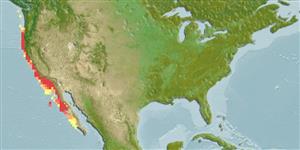Elasmobranchi (squali e razze) (sharks and rays) >
Torpediniformes (Electric rays) >
Torpedinidae (Electric rays)
Etymology: californica: Named after the state of California (Ref. 6885).
More on author: Ayres.
Environment: milieu / climate zone / depth range / distribution range
Ecologia
marino demersale; distribuzione batimetrica 0 - 906 m (Ref. 96339), usually 3 - 200 m (Ref. 55307). Temperate; 48°N - 23°N, 126°W - 110°W (Ref. 55307)
Eastern Pacific: Dixon Entrance, British Columbia, Canada to Sebastian Vizcaino Bay, Baja California, Mexico. Electric rays off Peru, Chile, and Japan may belong to this species (Ref. 2850).
Length at first maturity / Size / Peso / Age
Maturity: Lm ?, range 73 - ? cm
Max length : 140 cm TL maschio/sesso non determinato; (Ref. 12951); 137.0 cm TL (female); common length : 91.0 cm TL maschio/sesso non determinato; (Ref. 43939); common length :137 cm TL (female); peso massimo pubblicato: 0.00 g; Età massima riportata: 16 anni (Ref. 48844)
Short description
Chiavi di identificazione | Morfologia | Morfometria
Gray with scattered black spots dorsally, no ocelli. 1st dorsal fin much larger than 2nd. Spiracle margin smooth and without papillae.
Found on the outer continental shelf, around rocks, in kelp beds, over fine sand bottoms or buried in sand. Solitary, nomadic, and can remain suspended in the water with minimal swimming (Ref. 12951). Feeds on bony fishes, mainly herrings and halibuts. Ovoviviparous (Ref. 50449). Produces litters of up to 17 pups. Males reaches maturity at ca. 65 cm TL, females at ca. 73 cm TL (Ref. 114953). Attacks their prey from the substratum by day and actively forage at night with the aid of its electric organ discharge or EOD (Ref. 10011). The EOD of a large individual was measured at 50 V; with a low internal organ resistance the power output exceeded 1 kW (Ref. 10480). Aggressive when provoked but no human has yet been injured by the electric shock (Ref. 2850). Does not do well in aquariums (Ref. 12951).
Life cycle and mating behavior
Maturità | Riproduzione | Deposizione | Uova | Fecundity | Larve
Exhibit ovoviparity (aplacental viviparity), with embryos feeding initially on yolk, then receiving additional nourishment from the mother by indirect absorption of uterine fluid enriched with mucus, fat or protein through specialised structures (Ref. 50449).
Reproductive cycle appears to be annual in males and biannual in females (Ref. 48844). No defined birthing season (Ref. 48844).
Allen, M.J. and G.B. Smith, 1988. Atlas and zoogeography of common fishes in the Bering Sea and northeastern Pacific. NOAA Tech. Rep. NMFS 66, 151 p. (Ref. 6793)
IUCN Red List Status (Ref. 130435: Version 2024-1)
Human uses
Strumenti
Special reports
Download XML
Fonti Internet
Estimates based on models
Preferred temperature (Ref.
123201): 8.6 - 22.3, mean 12.8 °C (based on 100 cells).
Phylogenetic diversity index (Ref.
82804): PD
50 = 0.5001 [Uniqueness, from 0.5 = low to 2.0 = high].
Bayesian length-weight: a=0.01479 (0.00665 - 0.03288), b=2.96 (2.77 - 3.15), in cm total length, based on LWR estimates for this (Sub)family-body shape (Ref.
93245).
Trophic level (Ref.
69278): 4.5 ±0.80 se; based on food items.
Resilienza (Ref.
120179): Basso, tempo minimo di raddoppiamento della popolazione 4.5 - 14 anni (Fec = 17; tm=9; tmax=16).
Fishing Vulnerability (Ref.
59153): Very high vulnerability (79 of 100).
